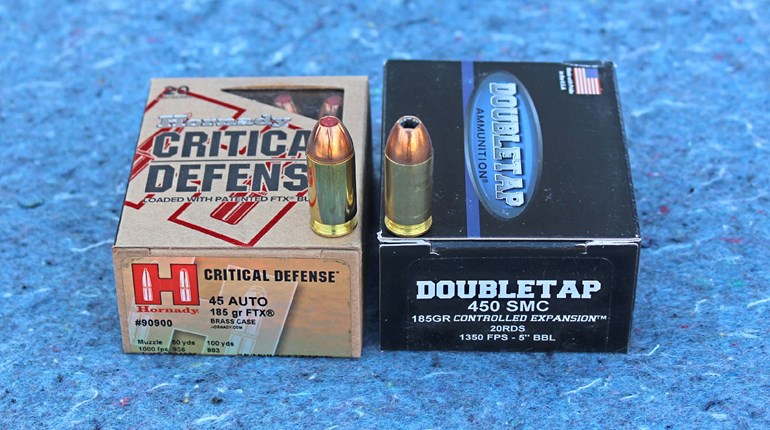
It’s hard to explain why some rounds thrive while others fade away. While all of these rounds can still be purchased from Underwood Ammo, they’re nearly impossible to find on most gun-store shelves.
I think it’s somewhat ironic that the most popular pistol cartridges for self-defense have been with us for more than 100 years—the 9 mm was introduced in 1902, and the .45 ACP in 1911. Since then, there have been a bunch of new, next-big thing, pistol cartridges introduced, and most have been commercial failures. Here’s a look at seven of these failed pistol cartridges and why they haven’t managed to hang around. Maybe one of them is exactly what you think you might need.
.460 Rowland (1977)
Developed in 1977, the .460 Rowland is a 40,000-psi derivative of the .45 ACP that was supposed to deliver near-.44 Mag. performance. The cartridge cases are very similar, but the Rowland case is .059-inch longer to prevent inadvertent chambering in a .45 ACP. One nice feature of a .460 Rowland pistol is that it can safely chamber and fire .45 ACP ammo. The Rowland will push a 230-grain bullet to about 1,400 fps from a 5-inch barrel. It may not be a true .44 Mag., but it’s close. Though never common for self-defense—partly due to its .44 Mag.-like recoil—the .460 Rowland has found limited favor with hunters and for bear defense. Many .45 ACP pistols can be easily converted to .460 Rowland with factory conversion kits.
.45 Win. Mag. (1979)
This cartridge is an elongated version of the .45 ACP, designed to handle about twice the pressure. It has an overall length (OAL) of 1.57 inches compared to the .45 ACP’s OAL of 1.27, and it will push a 230-grain bullet to around 1,600 fps, which puts it in the power range of the .44 Mag. Utah-based L.A.R. Manufacturing offered a 1911-style pistol chambered for the cartridge, but both were more successful as a novelty than anything else. The .45 Win. Mag. came to life in the late ’70s and passed into obsolescence long before most of the cartridges on this list were even born.
.400 Cor-Bon (1997)
Created by the founder of Cor-Bon ammunition, this cartridge is simply a .45 ACP case necked down to .40-caliber (10 mm). It will push a 140-grain bullet to around 1,400 fps, which is about 200 fps faster than the .40 S&W and a little slower than the hottest 10 mm loads. But, the .400 Cor-Bon operates at a lower pressure than both. It should have been more successful, but like the .45 ACP it was based on, the pistol’s limiting feature was capacity. In 1997, capacity was—just as it is today—a primary concern for those looking for a self-defense pistol.
.45 Super (1988)
Developed in 1988 by Gun World magazine editor Dean Grennell, the .45 Super was an effort to boost the performance of the .45 ACP. To circumvent the limits of the .45 ACP’s cartridge case, Grennell used a shortened, 1983-era .451 Detonics case, which was based on the .45 Win. Mag. (The .451 Detonics has also passed into obscurity.) The .45 Super was loaded to about 28,000 psi—about 5,000 psi more than .45 ACP +P ammo—and offered a velocity increase of about 250 fps. To be safe in conventional .45 ACP pistols, they needed to have a heavier recoil spring and a barrel with a fully supported chamber. The .45 Super proved to be more sensational than practical. Most felt their good old .45 ACP was plenty good enough.
.356 TSW (1992)
Designed by Smith & Wesson for IPSC competition in the early ’90s, the advantage this hyped up 9 mm offered was its ability to make the Major power factor in a greater-capacity pistol. Changing IPSC rules thwarted all this and the cartridge’s TSW name—which stood for “Tactical Smith & Wesson”—did not help it win the favor of non-competitive shooters. However, by 9 mm cartridge standards, it’s a screamer, pushing a 115-grain bullet to 1,600 fps, which is quite a bit more “super” than the .38 Super. It’s a bit curious why it was not more popular for self-defense, and some even say it is slated for a comeback. My money is on the side of we’ll never see a new .356 TSW pistol again.
.40 Super (1996)
Introduced in 1996, the .40 Super was developed by the failed Triton Ammunition Company and legendary bullet engineer Tom Burczynski. It’s nothing more than the .45 Win. Mag. cartridge case shortened and necked down to .40-caliber. The ballistics are rather impressive: it will push a 135-grain bullet to about 1,800 fps. This is a high-pressure cartridge, and it generates substantial recoil. Out of a steel-frame 1911, a 165-grain bullet at 1,500 fps recoils twice as much as a .40 S&W.
.45 GAP (2003)
The .45 GAP is a shortened .45 ACP cartridge to allow for a pistol grip that’s smaller in circumference. Glock felt it would appeal to law enforcement because it offered .45 ACP power in a pistol that would fit a wider array of hands. Everyone was excited when it was introduced in 2003, but in less than 10 years, few cared. At that time, cops were married to the .40 S&W. Glock still offers three pistols chambered for the .45 GAP, so it is the only cartridge on this list with any real legs left, but it’s hardly doing anything more than staggering around.
Ammunition for the Dearly (Nearly) Departed
What you might find just as interesting as these seven cartridges is that Underwood Ammunition offers at least one factory load for every one of them. Even more surprising is that the brass these Underwood Ammunition cartridges are loaded in is properly head stamped. So, while most of these cartridges might be mostly done for, if you decide one is just right for you, Underwood has you covered and, considering their rareness, prices are reasonable.




































